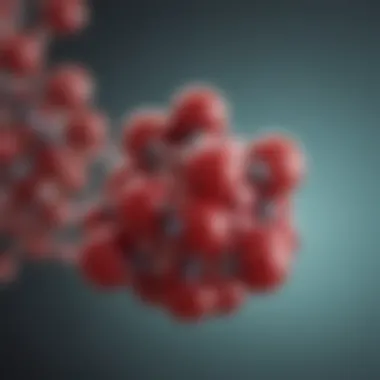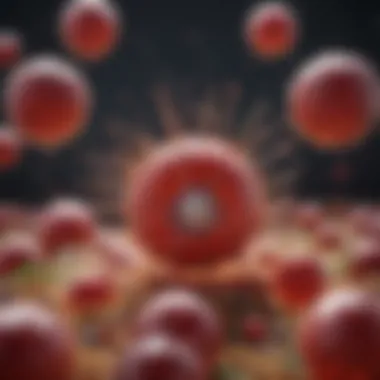Health Benefits of Quercetin According to Mayo Clinic


Intro
Quercetin is a flavonoid that’s being talked about quite a bit these days, especially among health-conscious circles. Found in a variety of fruits and vegetables, this compound packs a punch when it comes to potential health benefits. The Mayo Clinic offers insights that not only emphasize quercetin as an interesting subject of study but also highlight its growing relevance in promoting immunity and combating inflammation.
The connection between what we eat and how our bodies react is an old tale, but quercetin adds a new twist worth exploring. From onions to berries, the sources of this flavonoid are abundant. Yet, the question lingering in many minds is: what makes quercetin stand out from other dietary compounds?
By delving into the biochemical mechanisms and therapeutic uses outlined by the Mayo Clinic, readers can gain a clearer understanding of how quercetin interacts with bodily functions. This article aims to illuminate these aspects while ensuring a straight-to-the-point exploration that anyone—from seasoned researchers to curious novices—can grasp without getting lost in the weeds.
Foreword to Quercetin
Quercetin is fast becoming a hot topic in health and nutrition circles. As we peel back the layers of this flavonoid, we discover its significance not only in the realm of dietary supplements but also for its broader implications for human well-being. The explorations conducted by esteemed institutions such as the Mayo Clinic serve to shine a light on various aspects of quercetin, including its potential health benefits and mechanisms of action.
Understanding quercetin is not merely about knowing what it is, but about recognizing its myriad effects. This flavonoid, thought to possess various therapeutic properties, can be particularly valuable for those interested in enhancing their health through dietary means. Sources rich in quercetin, ranging from fruits to herbs, contribute to its growing popularity.
In the sections that follow, we will delve into the definition and structure of quercetin, spotlighting how its molecular makeup aligns with its healthful benefits. Furthermore, by examining key sources of quercetin, we’ll highlight how one's diet can serve as a vehicle for its intake. This foundational knowledge sets the stage for a deeper exploration of the compound’s role in immunity, inflammation, and overall health, ultimately underlining why quercetin deserves a seat at the table in discussions about nutritional science.
Definition and Structure of Quercetin
Quercetin is a plant pigment, or flavonoid, classified under the category of polyphenols. Its structure is characteristic of flavonoids, comprising a benzene ring connected to a 3-hydroxyflavone backbone. The specific arrangement of hydroxyl groups on this backbone significantly contributes to its antioxidant properties, enabling it to combat oxidative stress in the body. This antioxidant capability is essential for protecting cells from damage, thus fostering an environment supporting overall health.
Sources of Quercetin
Quercetin can be found in various food sources, allowing individuals to incorporate it seamlessly into their diets. Understanding where to find quercetin-rich foods can materially influence health choices.
Fruits
Fruits such as apples, berries, and citrus are considered rich sources of quercetin. These colorful options not only appeal to the palate but also pack a nutritional punch. The skin of apples, particularly, is loaded with quercetin, making it a good reason to eat them with the peel on. Including fruits in your daily diet can enhance overall health while indulging in their natural sweetness.
Vegetables
Certain vegetables, such as onions, kale, and broccoli, are well-known for their quercetin content. Onions, especially red onions, are one of the highest sources. This pungent vegetable not only adds flavor but brings with it the benefits of quercetin. Incorporating such vegetables into meals can help bolster one's intake, alongside providing other vital nutrients.
Herbs
Herbs, such as capers and parsley, are often overlooked sources of quercetin but can be powerhouses of nutrition. These condiments can easily be added to various dishes, enhancing both flavor and health benefits. For those sprucing up their meals, using herbs not only makes food tastier but also enriches it with these beneficial compounds.
Supplements
For individuals who find it challenging to get adequate quercetin through food alone, supplements become a viable option. These can be particularly useful for those wishing to reap the concentrated benefits of quercetin. It’s worth noting, however, that one should approach supplementation thoughtfully, considering both dosage and potential interactions with other medications or nutrients.
Mayo Clinic's Perspective on Quercetin
The Mayo Clinic stands at the forefront of medical research, and its insights on quercetin bring a wealth of knowledge to the discussion surrounding this promising flavonoid. Quercetin is much more than a mere compound found in fruits and vegetables; it's a focus of ongoing studies aimed at understanding its multifaceted health benefits. Given the clinic's reputation for rigorous research, their perspective offers considerable weight as we explore the various implications and considerations related to quercetin.
The significance of the Mayo Clinic’s perspective lies in its scientifically validated approach to health claims. Their findings are grounded in clinical research that targets real-world applications of quercetin in improving various health conditions. As health professionals sift through the mountain of information available, the Mayo Clinic's contributions shine a light on evidence-based insights that help clarify the potential roles of quercetin in promoting wellness.
Research Overview
Study Design


In exploring quercetin, the Mayo Clinic employs a variety of research designs, but randomized controlled trials are of particular note. This design is akin to putting a flashlight on the darker corners of medical knowledge. The randomization presents a significant advantage, allowing researchers to compare the effects of quercetin against a placebo, thereby narrowing down the effects directly associated with the flavonoid itself. By focusing on a controlled environment, the clinic manages to eliminate a number of variables that might skew the results, lending credence to their findings.
One key characteristic of this study design is the double-blind setup, which minimizes biases since neither the participants nor the researchers know who is receiving the active compound. This design is popular because it provides robust data that can significantly influence treatment protocols. However, it can also come with its downsides. For instance, the strict control can sometimes limit the real-world applicability of the results, as participants in these trials may not fully represent the general population.
Target Population
The Mayo Clinic’s research into quercetin also places emphasis on a diverse target population, which reflects the complexity of human health. The clinic often recruits participants of various ages, ethnicities, and health backgrounds to create a holistic view of how quercetin affects different groups. This is crucial, as the relevant metabolic pathways might differ according to genetics or diet.
This characteristic of including a varied demographic enhances the reliability of findings and helps in devising tailored interventions that consider individual differences. However, the diversity also means that it may be challenging to draw direct conclusions. Results that are effective in one group might not translate uniquely across others, introducing a layer of complexity to the interpretation of the data.
Health Claims and Effectiveness
Supported Claims
Among the numerous health claims attributed to quercetin, those backed by Mayo Clinic research stand out for their reliance on strong evidence. The clinic has published findings substantiating quercetin's roles in combatting inflammation and bolstering immune response. These supported claims not only highlight quercetin’s potential as an antioxidant but also reinforce its therapeutic implications in managing chronic diseases such as cardiovascular disorders and allergies. The fact that many of these claims originate from peer-reviewed studies adds an extra layer of dependability.
A unique feature of these supported claims is their backing through not jus observational studies but also controlled trials. This builds a robust foundation for healthcare professionals to consider quercetin as a potential adjunct therapy in certain clinical settings. Unfortunately, hype surrounding some of these claims can lead to misuse or misunderstandings, emphasizing the need for thorough patient education on appropriate usage.
Controversial Aspects
Despite the glowing benefits, not all aspects of quercetin are black and white. Mayo Clinic’s perspective also sheds light on the controversial elements surrounding quercetin that deserve attention. For one, the bioavailability of quercetin can be a topic of debate. Studies indicate that while it is naturally present in many foods, the absorption into the human system—when taken through diet versus supplements—differs, leading to varied reporting on effectiveness.
Highlighting these controversial aspects offers a more nuanced view of quercetin. It informs both professionals and consumers to be critical when interpreting the data and making decisions. Additionally, open discussion around these uncertainties allows for ongoing research and discovery, which ultimately benefits everyone involved in the field of health and nutrition.
Mechanisms of Action
Understanding how quercetin works within the body is the key to appreciating its potential health benefits. This flavonoid operates through various mechanisms, largely focusing on its roles as an antioxidant, anti-inflammatory agent, and a modulator of immune function. Each of these areas contributes to its overall efficacy in promoting health and preventing disease. By diving into these mechanisms, we can outline quercetin's multifaceted impact on human biology, aiding both professionals and the general public in grasping its importance.
Antioxidant Properties
Quercetin stands out for its antioxidant capabilities, capturing attention for its ability to neutralize free radicals. Free radicals are unstable molecules that can cause oxidative stress, leading to cellular damage and various health issues, including chronic diseases. Essentially, quercetin's role in this arena involves scavenging these harmful molecules, helping to maintain cellular integrity.
Research has shown that quercetin can enhance the body's natural defense systems, improving the functionality of enzymes responsible for detoxifying these free radicals. It's noteworthy that something as simple as adding more quercetin-rich foods to our diet could potentially alter the landscape of oxidative stress in the body. Whereas one can slide by with a lackluster diet, introducing foods like onions or apples could be the game-changer for some.
Anti-inflammatory Effects
Impact on Chronic Inflammation
Chronic inflammation has become a buzzword in discussions about modern health issues, as this condition underlines numerous diseases, from arthritis to heart ailments. The ability of quercetin to wield influence in this area makes it a hot topic of research. This flavonoid can inhibit the production of pro-inflammatory cytokines, which are proteins that signal inflammation. In simple terms, quercetin can help curb the body's inflammatory response that, when unchecked, can spiral into serious health concerns.
The characteristic of quercetin here lies in its capacity to modulate signaling pathways involved in inflammation, particularly the NF-kB pathway, which plays a pivotal role in regulating immune response. Its unique feature involves not just reducing inflammation but also addressing the root causes of chronic inflammation, making it a potentially invaluable addition to a health-conscious regimen.
Clinical Implications
The clinical implications of quercetin's anti-inflammatory effects are vast. This compound's ability to mitigate inflammation opens doors to therapeutic applications in treating conditions such as asthma and chronic pain syndromes. At the same time, it offers a natural alternative to conventional anti-inflammatory medications, which can often bring along a slew of unwanted side effects.
Highlighting these clinical implications is vital. Quercetin's properties may enable healthcare practitioners to incorporate it into treatment plans aimed at managing chronic inflammatory conditions. However, its unique nature lies in the fact that it’s more than just a temporary fix; it could foster long-term health benefits by promoting an overall more balanced inflammatory response in the body.
Role in Immune Function
Quercetin also plays a significant role in strengthening immune function, a timely topic given the worldwide focus on boosting immunity in recent years. This flavonoid can enhance the capacity of immune cells, such as macrophages and T cells, to fight off pathogens effectively.


By modulating various immune responses, quercetin can help the body mount a more efficient attack against infections and even contribute to reducing the severity of autoimmune reactions. The implications here stretch beyond mere defense; they push us towards understanding how dietary choices can tangibly improve our immune resilience.
Potential Health Benefits of Quercetin
The spotlight in health discussions often shifts towards nutrients that can significantly improve bodily functions and disease prevention. Quercetin stands out as a prominent flavonoid, appearing in a variety of fruits and vegetables. It is gaining traction for its potential health benefits, which warrant serious consideration. In exploring these benefits, we can highlight three key areas: cardiovascular health, cancer prevention, and allergy/asthma management.
Cardiovascular Health
Mechanisms Supporting Heart Health
Quercetin plays a role in promoting cardiovascular health through various mechanisms. One of the main ways it operates is by enhancing endothelial function. The endothelium, thin layer of cells lining blood vessels, serves a critical function in regulating blood flow and pressure. When quercetin is consumed, it exhibits the ability to bolster nitric oxide production, which in turn relaxes blood vessels, improving their elasticity. This characteristic is vital in preventing chronic conditions such as hypertension.
Moreover, quercetin's antioxidant properties contribute to the reduction of inflammation in blood vessels. By neutralizing free radicals, it curbs oxidative stress—an essential factor in atherosclerosis, where arteries become clogged due to plaque buildup. Thus, quercetin is not only a beneficial addition to a heart-healthy diet; its unique properties may serve as a preventive measure against heart disease.
Clinical Evidence
The clinical evidence surrounding quercetin’s efficacy in cardiovascular health is robust. Various studies have documented its positive impacts on blood pressure and cholesterol levels. For instance, a meta-analysis supports the conclusion that quercetin supplementation can lead to significant reductions in systolic and diastolic blood pressure among hypertensive individuals. This characteristic alone makes quercetin noteworthy within cardiovascular research.
Another intriguing aspect is its potential to improve lipid profiles. Some clinical trials have indicated that quercetin can reduce LDL cholesterol levels while increasing HDL cholesterol, contributing to overall better heart health. These findings position quercetin as a compelling choice in discussions surrounding heart disease prevention.
Cancer Prevention
Evidence from Laboratory Studies
Laboratory studies exploring quercetin's effects on cancer cells reveal promising potential. In vitro and animal studies have shown that quercetin can induce apoptosis, a process that leads to programmed cell death in cancer cells. This unique feature makes it a subject of interest. It points toward a future where quercetin could be integrated into cancer therapies, providing a supplementary approach alongside conventional treatments.
The ability of quercetin to inhibit tumor formation has also been observed in various cancers, including breast and colon cancers. Its interaction with molecular pathways that regulate cell growth and survival provides a captivating insight into its anticancer properties. This characteristic makes quercetin a fascinating area of study for researchers aiming to uncover safer and effective treatment strategies.
Current Clinical Trials
Current clinical trials expanding the knowledge around quercetin's cancer preventive properties emphasize translational health. Some ongoing studies focus on its administration alongside chemotherapy agents to enhance their effectiveness and reduce side effects. As research unfolds, it is crucial to monitor these trials' outcomes closely, as they might position quercetin as a valuable adjunct in cancer treatment.
The unique feature of these trials is the hope they instill within the scientific community. If quercetin can be proven to increase the efficacy of traditional chemotherapy, it would mark a significant milestone in oncological care. Hence, keeping an eye on these developments is pivotal.
Allergy and Asthma Management
Effects on Histamine Release
When it comes to allergy and asthma management, quercetin's ability to inhibit histamine release is notable. Histamines are chemicals in the immune system that are released during allergic reactions, leading to symptoms like swelling, redness, and itching. By stabilizing mast cells, which release histamine, quercetin acts as a natural antihistamine, potentially providing relief to those with allergic sensitivities.
This characteristic offers a promising avenue for symptomatic relief. Regular consumption of quercetin may help in reducing the severity of allergic reactions, making it an appealing topic in discussions about natural allergy management.
Clinical Application
The clinical application of quercetin in allergy management is an area that needs further exploration, but current evidence supports its role as a complementary treatment. Studies examining quercetin's effect on certain allergic conditions, such as hay fever, indicate that it can diminish symptoms like sneezing and nasal congestion, thus improving quality of life.
Moreover, using quercetin as a supplementation strategy could offer a safer alternative to over-the-counter antihistamines, which often come with side effects. Recognizing the unique advantageous qualities of quercetin in improving the management of allergies positions it as an important consideration in the holistic approach to health.
Dosage and Bioavailability
Understanding the dosage and bioavailability of quercetin is crucial for harnessing its potential health benefits. Quercetin, as a flavonoid, needs to be present in sufficient amounts and be adequately absorbed by the body to exert its positive effects on health. Many factors can influence how much of this compound one can benefit from, including dietary intake, natural absorption rates, and interactions with other substances.


Recommended Intake Levels
Current research suggests varying intake levels of quercetin depending on the intended health benefit. Generally, a common recommendation hovers around 500 mg to 1000 mg per day as a supplement. However, this doesn’t account for those who might be sourcing quercetin through diet alone. Foods rich in quercetin, such as apples, onions, and grapes, contain varying amounts, typically providing a fraction of the dose found in supplement form. While enjoying a colorful plate of fruits and veggies is always encouraged, some individuals might find that achieving therapeutic levels solely through diet can be a challenge. Customizing intake based on personal health objectives may be wise.
Factors Influencing Absorption
The effectiveness of quercetin doesn't just hinge on how much you take; it's also about how well it gets absorbed in the body. Here are a couple of factors that play a noteworthy role.
Food Interactions
When it comes to food interactions, quercetin is best absorbed when consumed alongside fats. This characteristic stands out since quercetin is a fat-soluble flavonoid, meaning that pairing it with some healthy fats, like avocados or nuts, can amplify its benefits. However, consuming this flavonoid with certain foods might inhibit its absorption. For example, high amounts of tea or coffee can have a negative impact. Thus, being mindful of what you eat with quercetin-rich foods is necessary. This interaction could greatly influence overall effectiveness, making meal planning an integral part of maximizing the health advantages of quercetin.
Combinations with Other Nutrients
Another important aspect is how combinations with other nutrients can affect the absorption and usefulness of quercetin. When paired with vitamin C, quercetin can potentially enhance its antioxidant capacity. This partnership is promising not just because of the synergistic benefits but also because these nutrients are often found together in foods like citrus fruits and bell peppers. However, combining quercetin with excessive levels of processed sugars might dampen its positive effects. It is prudent to eat quercetin in a balanced diet rich in whole foods to avoid this pitfall, as the right combinations may support the body's use of this powerful flavonoid in a more effective way.
Safety and Side Effects
When delving into the world of health supplements, it’s crucial to keep an eye on safety and side effects, especially with compounds like quercetin. While this flavonoid offers numerous health benefits, understanding the potential risks involved is essential for making informed decisions. Knowledge of safety aspects helps consumers optimize the benefits of quercetin while minimizing potential unwanted reactions.
Common Side Effects
Quercetin generally boasts a good safety profile; however, it is not without its share of common side effects. Individuals may experience the following:
- Gastrointestinal Discomfort: Nausea and stomach cramping can sometimes occur, especially when quercetin is taken in high doses.
- Headaches: Some users report experiencing headaches, which could be due to various factors, including the compound's interaction with other medications.
- Allergic Reactions: Although rare, those allergic to onions or apples, both rich in quercetin, may experience skin rashes or respiratory issues.
It is important to note that these side effects are generally mild and often resolve quickly once the body adjusts or when the dosage is reduced.
Precautions and Contraindications
Being mindful of certain precautions can be the key to safely incorporating quercetin into one’s diet. Before embarking on a quercetin regimen, consider the following:
- Pregnant and Nursing Women: Limited studies exist on the safety of quercetin for pregnant or breastfeeding women. It’s best to consult a healthcare provider first.
- Medication Interactions: Quercetin may interact with various drugs, such as blood thinners like warfarin or certain medications that affect liver enzymes. It’s essential to speak to a doctor if you are on such medications to avoid any complications.
- Chronic Health Conditions: Individuals with pre-existing conditions, particularly those affecting the kidney, should consult a healthcare professional before adding quercetin to their routine.
Always prioritize safety and consult with a healthcare professional when considering dietary changes or supplements that could impact your health.
Being thoughtful about these aspects can help ensure a safe and beneficial experience when using quercetin to boost overall wellness.
Finale
The exploration of quercetin’s benefits provides crucial insights into its role in health and dietary habits. As discussed throughout this article, quercetin presents a myriad of advantages ranging from its potential anti-inflammatory and antioxidant properties to its promising role in managing allergies and supporting cardiovascular health. Understanding these aspects enhances not only awareness about dietary choices but also fosters further interest in related nutritional research.
Summary of Benefits
Quercetin stands out prominently due to its multi-faceted effects on health. Here are key benefits for consideration:
- Antioxidant Activity: Quercetin acts as a potent antioxidant, helping to neutralize free radicals which can damage cells. This is particularly important in preventing chronic diseases such as cancer and heart disease.
- Anti-Inflammatory Effects: Research suggests that quercetin can significantly reduce inflammation, which is often at the root of numerous health issues, including arthritis and metabolic syndrome.
- Immune Support: The compound's influence on immune function is noteworthy. Some studies indicate that it could bolster the immune response, making it a potential ally against infections.
- Respiratory Health: Quercetin's capacity to inhibit histamine release can be beneficial in managing allergy symptoms and asthma.
The research highlighted from the Mayo Clinic provides a strong foundation demonstrating the various ways quercetin can enhance health.
Future Directions in Quercetin Research
While current studies assist in solidifying the understanding of quercetin, numerous avenues for future research remain open:
- Long-term Clinical Trials: More extensive human studies are necessary to evaluate the long-term effects of quercetin supplementation across diverse populations.
- Bioavailability Studies: Given the complexities around how well the body absorbs quercetin, further research to enhance its bioavailability will be crucial. Improving absorption rates through novel methods could maximize its health benefits.
- Mechanistic Studies: Understanding the precise biological mechanisms through which quercetin exerts its effects will help in assessing its therapeutic potential for specific conditions.
- Interactions with Other Nutrients: Research into how quercetin works in synergy with other dietary components could uncover new strategies for dietary recommendations and supplementation.
In summary, quercetin has carved out a significant niche in dietary health. Its potential benefits, supported by research, highlight the need for continued investigation to unlock its full capabilities and applications.







